Strelitzia spp.
If you are looking for a plant with large, show-stopping blooms, look no further than the bird of paradise.
With its orange, blue, and white flowers that look like a bird in flight, this plant just cannot be ignored.
And this South African native will grow happily year-round throughout warmer parts of the US.
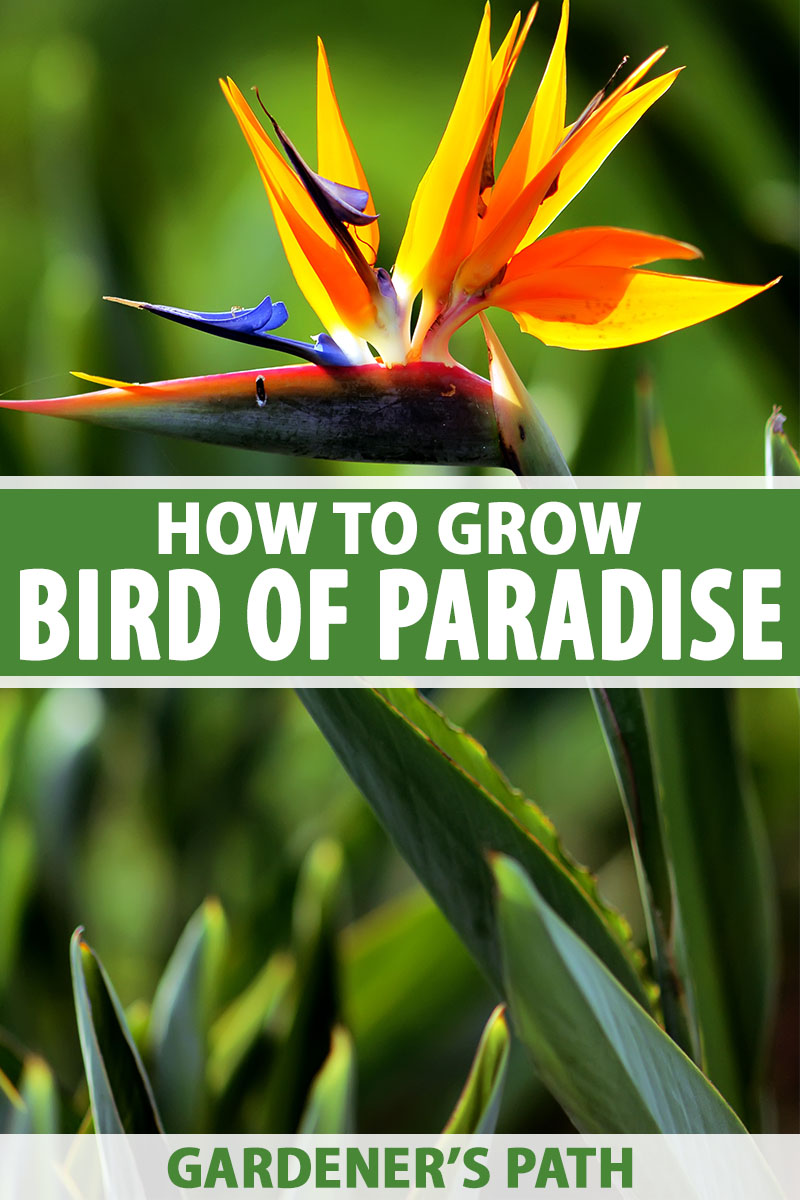
We link to vendors to help you find relevant products. If you buy from one of our links, we may earn a commission.
Ready to get started? I’ll explain everything you need to know to grow vigorous bird of paradise plants in your own garden in Zones 9-12.
Here’s what’s ahead:
What You’ll Learn
What Is Bird of Paradise?
This herbaceous perennial is rare in northern climates, but prevalent in gardens and on roadsides in USDA Hardiness Zones 10-12 and sometimes in warmer areas of Zone 9 as well.
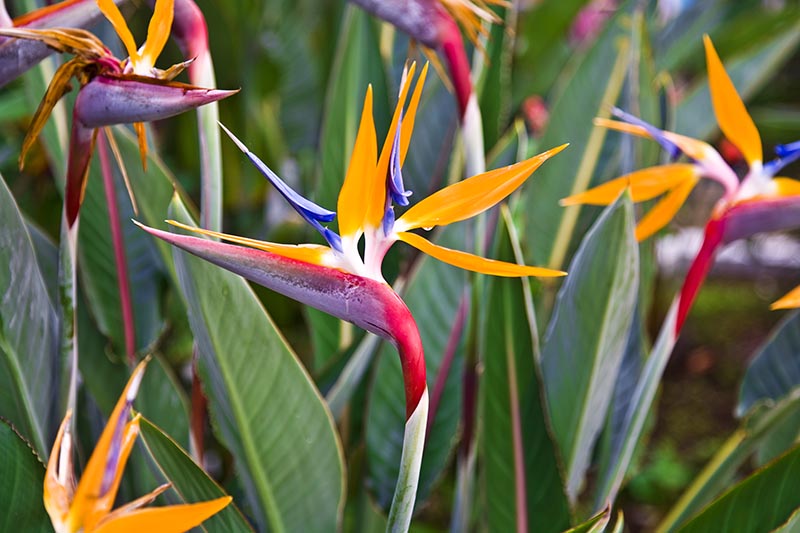
Named for its stunning flowers, the plant grows slowly in clumps as its underground stem divides, while the foliage grows in a fan-like pattern and resembles banana leaves.
Flowers are produced in groups of one to three on long stalks.
Bird of paradise plants are also known as crane flowers, a more precise description of the shape of their blooms.
Orange sepals and blue petals emerge from a modified leaf known as a bract. Two of the blue petals join together to form a nectary – an organ that secretes nectar.
The plants bloom off and on year round in suitable climates.
Mature, healthy plants can produce up to 36 flower spikes a year, which will last for weeks.
Native to southern Africa, there are five species in the Strelizia genus. The most common species grown in the US are S. reginae, S. nicolai, and S. alba.
If you live in the southwestern US, you may be familiar with other plants known by the same common name.
The birds of paradise that grow so well in this region are an entirely different species in the legume family, Caesalpinia.
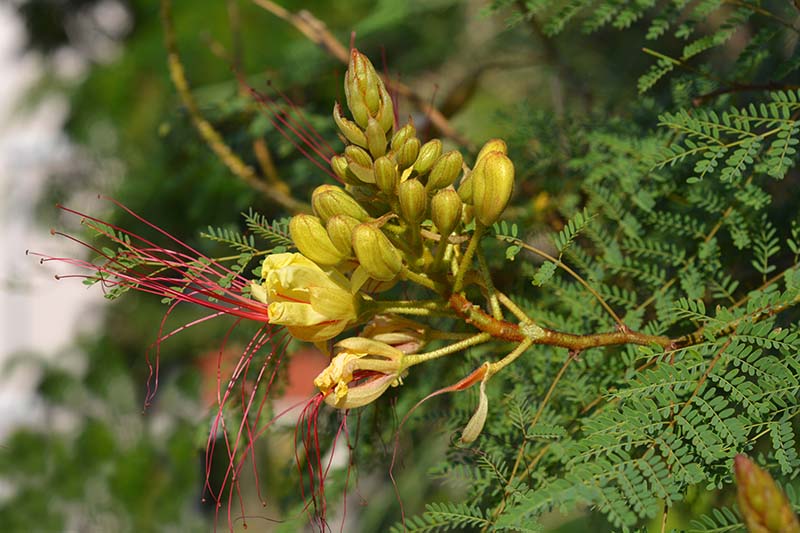
The three most commonly seen are the red C. pulcherrima, yellow C. gilliesii (reclassified as Poinciana gilliesii), and the Mexican bird of paradise, C. mexicana.
Cultivation and History
Once considered part of the banana family, these plants have escaped this lowly fate and now have their own family – the Strelitziaceae.
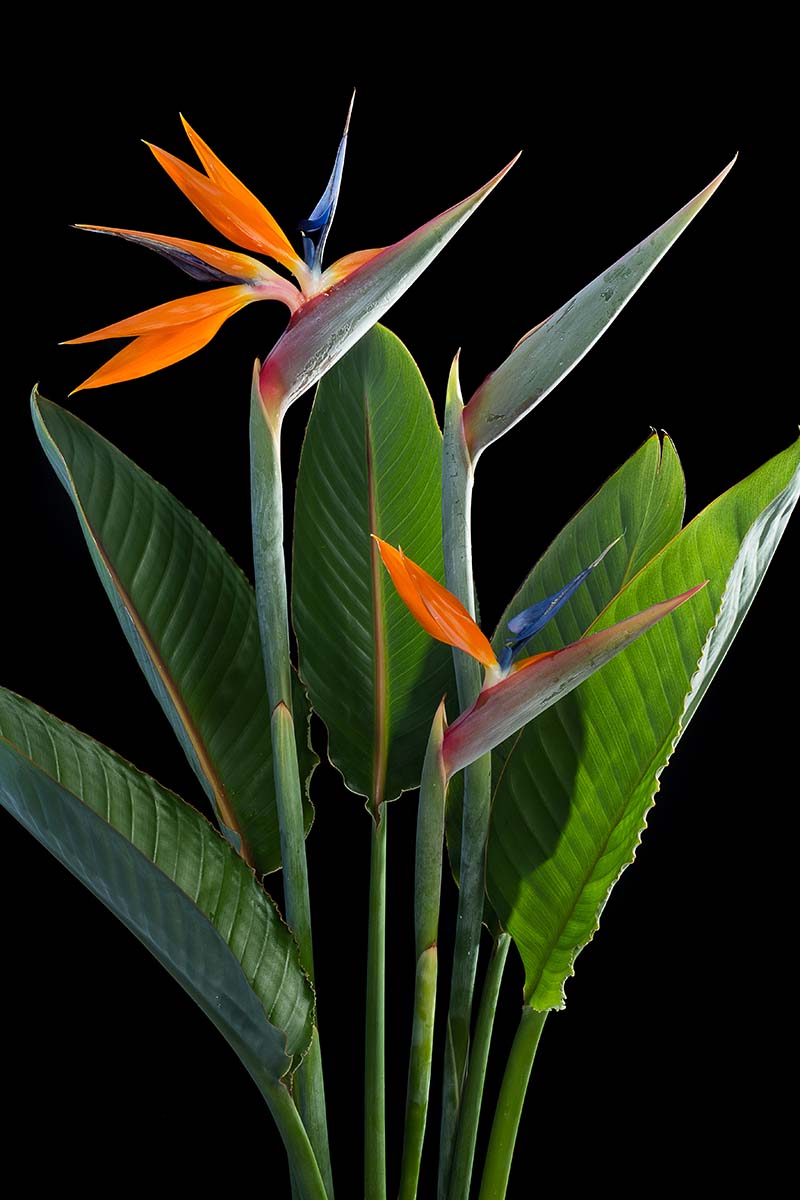
Bird of paradise flowers are so storied that they were a recipient of the Award of Garden Merit from the UK’s Royal Horticultural Society in 1993.
They are delightful as cut flowers and are sold by the million for use in floral arrangements.
These plants are low maintenance which makes them valuable for urban landscaping. They are commonly seen growing in traffic islands and in gardens in apartment complexes in California.
Even better is their tendency to stay put. Unlike tree roots that will eventually lift sidewalks, bird of paradise roots do not thicken as the plants age.
Bird of paradise plants were introduced to Europe in 1773 when Francis Masson, plant collector, brought specimens from the eastern Cape region of South Africa to the Royal Botanical Gardens at Kew.
The genus Strelitzia was named for Queen Charlotte Sophie of Mecklenburg-Strelitz, the wife of the reigning monarch at the time, King George III.
Even the scientific name of the common bird of paradise, S. reginae, is regal, with the Latin word reginae translating to queen in English.
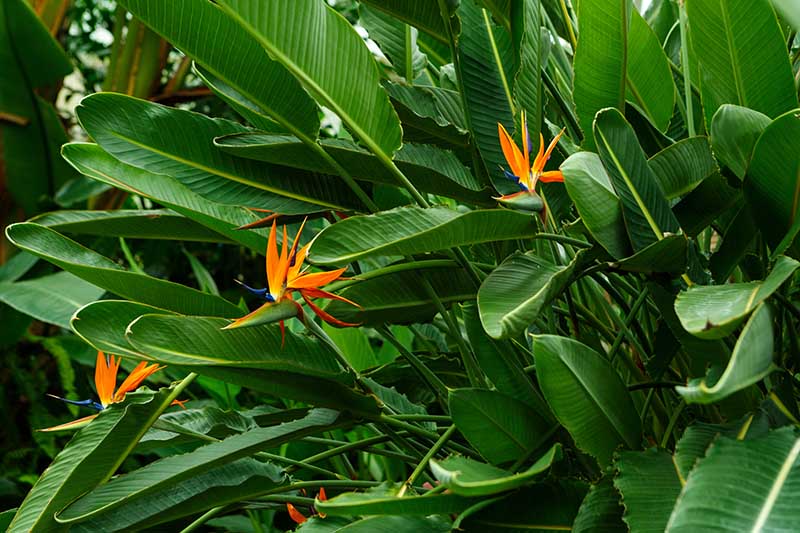
Bird of paradise plants were introduced into California in 1853 by Colonel Warren, editor of the California Farmer magazine, and were available for sale in Montecito, a wealthy enclave of Santa Barbara in the 1870s.
These plants became such emblems of southern California that in 1952 they were named the official flower of the city of Los Angeles by Mayor Fletcher Bowron.
In their native South Africa, the flower is so popular that it is featured on the coat of arms of the province of KwaZulu-Natal.
It also adorns the emblem of a high South African honor – the Order of the Ikhamanga. The president of South Africa has the power to grant this honor to citizens for achievements in literature, culture, arts, journalism, music, and sports.
Bird of paradise plants grow wild among other shrubs along riverbanks in many parts of South Africa, and are important sources of nectar for birds.
Strelitzia Plant Propagation
Growing bird of paradise plants from seed can take three to 10 years, but propagating them by division produces new plants much more quickly.
By Division
You can dig up mature clumps in late spring or early summer and divide those with four to five shoots or more into single- or multiple-stem divisions.
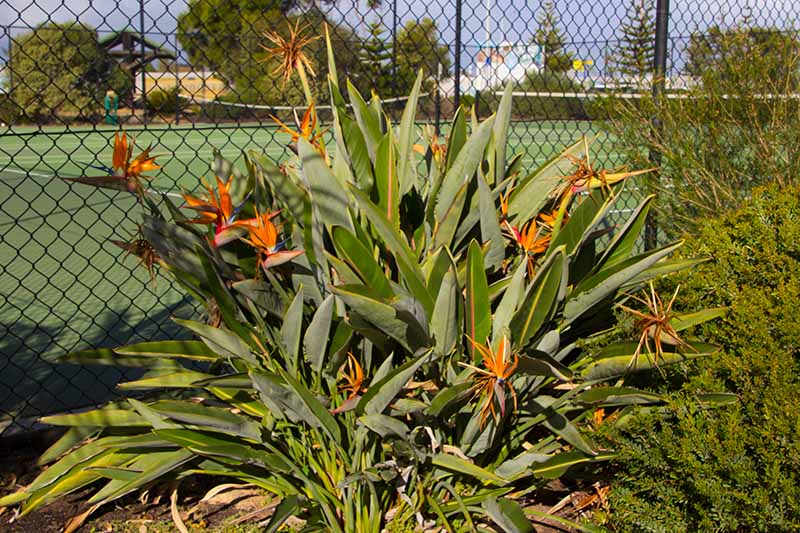
Depending on the size of the clump, you’ll need to mark a radius eight to 12 inches out from the base of the plant, and dig down to a depth of 10 to 24 inches. Pull up the plant and cut through the root ball cleanly with a gardening knife or shovel.
If the plant is growing in a container, lift it out of the pot, and cut through the root ball with a sharp knife. Make sure each section has at least one stem attached.
Plant each division in the ground at the same depth as the section of root ball or into a pot eight to 12 inches wide and deep – or larger – depending on the size of your division.
Keep the soil moist for at least three months until the roots are established. Then, if desired, you can start fertilizing them as described below.
You should have mature flowering plants in one to three years.
Another option is to remove young offshoots from mature plants.
Learn more about how to divide bird of paradise flowers in this guide.
From Seed
If you are patient, you can grow these plants from seeds. Your plants should start blooming in three to five years.
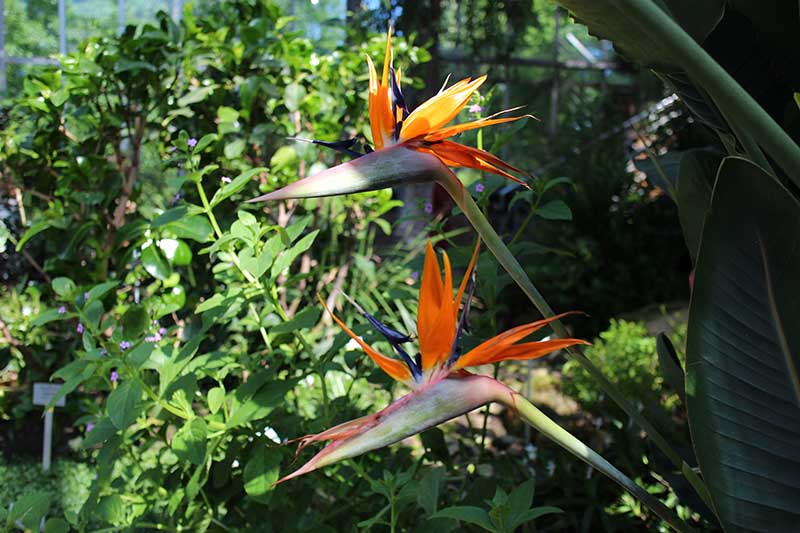
However, some sources claim that it can take as long as 10 years for plants that were started from seed to bloom.
Saving your own seeds from mature plants is an option, but if the plants are hybrids the seeds will not produce true to the parent plant.
If you hand pollinate the flowers, you should see seed pods about five months later. Each pod will contain 60-80 seeds.
When the flower has withered and died back, you can collect the pods and cut them open to remove the seeds inside.
The seeds are black with orange tufts and are the size of sweet pea seeds.
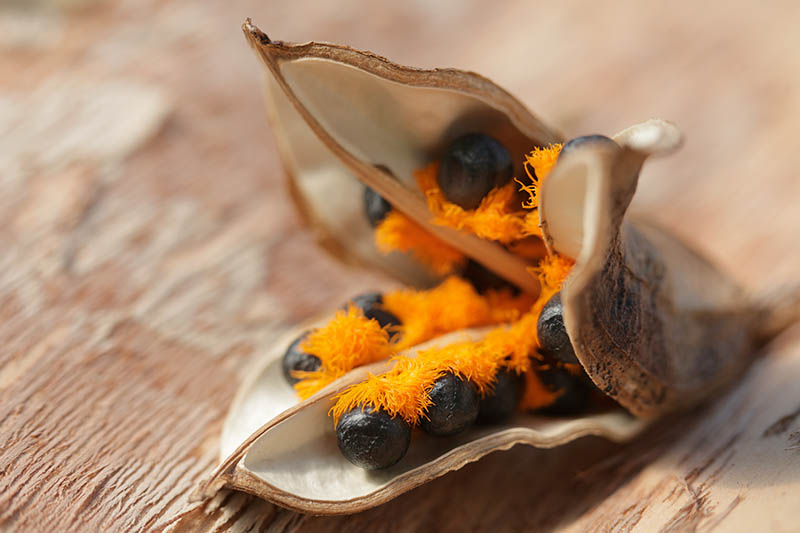
Plant the seeds as soon after harvest as possible, before the seed coat becomes hard.
If you can’t sow them immediately, planting within six months of harvest is recommended to ensure viability.
If you need to store the seeds, place them in a cool, well ventilated room until the seeds have completely dried out – typically a week to ten days – then transfer to a paper envelope and store in a cool, dry place until you are ready to plant.
If the seed coat is hard, whether you’ve saved your own seeds or purchased them, you can decrease the germination time by soaking the seeds in lukewarm water for one to two days, and then nicking the seed coat with a small file or knife. This process is known as scarification.
Remove the bright orange tuft of hairs after you have soaked the seeds.
Sow the seeds 1/2 to one inch deep in a pot or planting tray in a moist seed starting medium that is loose and clean. Place a plastic bag or humidity dome over the top to maintain a humid environment.
Providing bottom heat of 75-90°F will help them to germinate, although it is not necessary.
Seeds that have been scarified should germinate in one to three months if kept moist.
According to Sydney Park Brown and Robert J. Black, professors at the Environmental Horticulture Department at the University of Florida IFAS Extension, you may be able to speed up the germination time by putting the seeds in a plastic bag and refrigerating them at 40-45°F for two weeks. Then scarify them.
The seedlings can be transplanted to six-inch pots when they have three to four true leaves.
Keep the soil evenly moist but not waterlogged until seedlings are six to eight inches tall before transplanting them into the garden as described below.
How to Grow Bird of Paradise Flowers
While this plant originates in the subtropical coasts of South Africa, it will grow in the warmer climates of Zones 9-12.
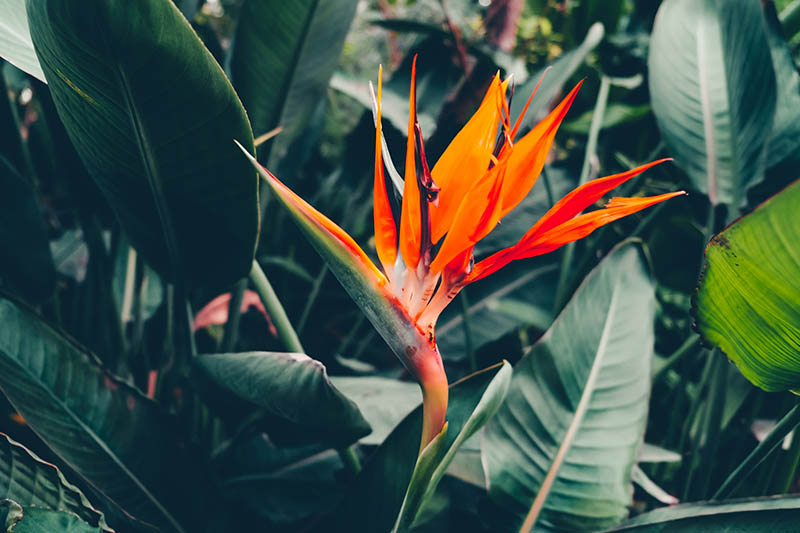
Birds of paradise should be planted in a full sun location, although they can thrive in partial shade in subtropical climates such as Florida.
The characteristics of the plants will differ depending on the amount of light they receive.
Plants grown in full sun are smaller and have shorter flower stems, while those grown in partial shade are taller and may have somewhat larger flowers.
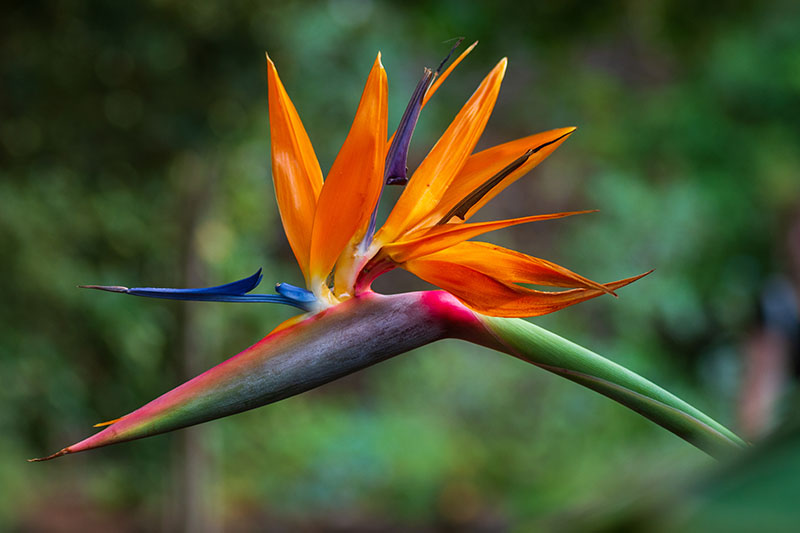
Since the plants produce more flowers around the outside of the plant, spacing them at least six feet apart will allow adequate room for the flowers to develop.
To transplant into the garden, dig a hole that is two to three times the diameter of the root ball and as deep as the height of the root ball. Thoroughly water the plant before gently removing it from the container.
Take care not to disturb the roots as those of young plants are easily damaged.
Place the plant in the hole, and make sure the top of the root ball is even with the surface of the soil. Backfill with soil and water in well.
If bird of paradise is planted too deeply, this may delay flowering.
You can create a basin like a saucer around the plant, so it will hold water until it drains to the roots.
Make sure to water the plant regularly during the first six months after planting. Water deeply when the surface of the soil feels dry to the touch.
Soil and Climate Needs
Bird of paradise plants are pretty forgiving and will grow in a range of soil types.
However, they grow best in organically-rich, loamy soil that drains well with a pH of 5.5-7.5.
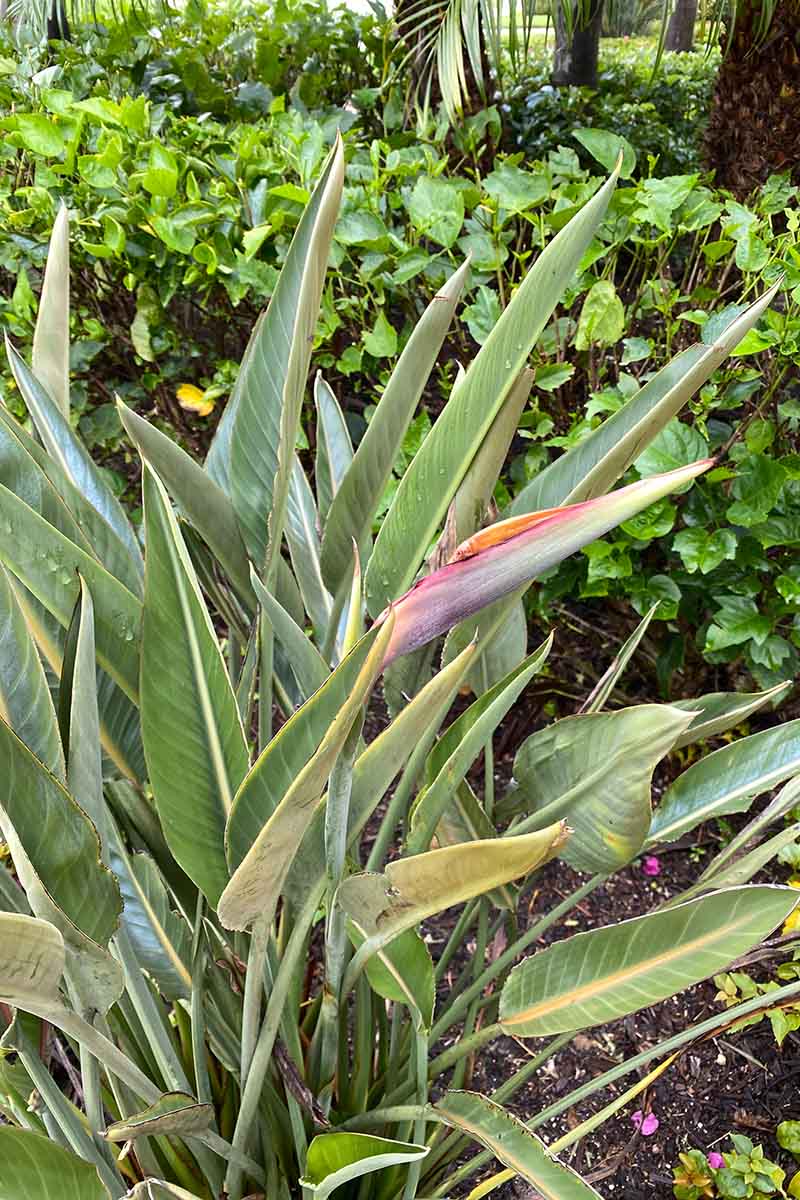
The plants can briefly tolerate temperatures as low as 24°F, although freezing temperatures will damage developing flowers and buds.
If you live in an area prone to freezes, either cover your plants if a hard freeze is in the forecast, or bring pots inside when the weather gets cold.
Too learn more, we cover growing bird of paradise indoors as a houseplant here and how to overwinter your plants here.
Watering and Mulching
If this type of plant receives too much or too little moisture, the leaves will turn yellow and eventually die.
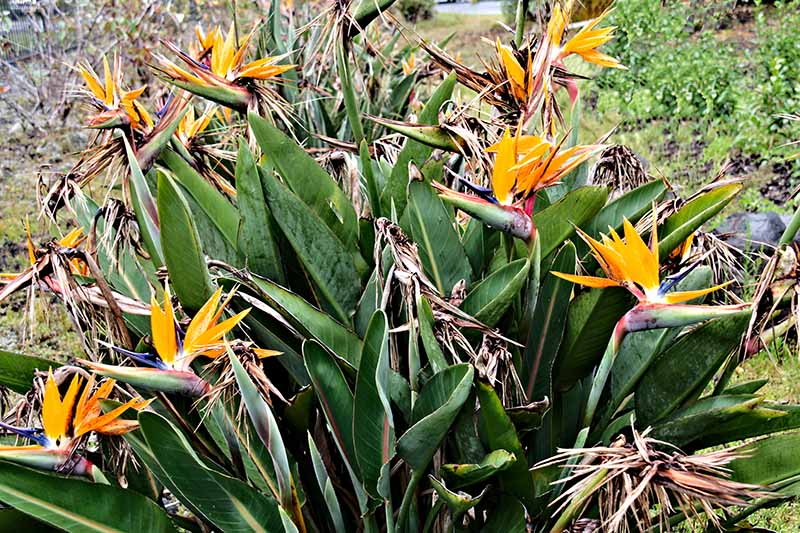
Mature plants are generally drought tolerant and will need to be watered when the top three inches of the soil is dry. They will not tolerate wet feet and waterlogged soil can cause root rot.
During the winter months, if there is sufficient rain, you may not need to provide any additional irrigation.
Place a two to three-inch-deep layer of mulch around the base of the plant. This will help to conserve moisture, reduce weed infestations, and provide micronutrients.
Do not add mulch too close to the stem. Keeping a two to three-inch circular area around your plants free of mulch will protect against stem rot.
Organic mulches – such as wood chips, bark, pine needles, or leaves – are suitable, as are crushed stone or gravel in areas where lighter materials may blow away.
Fertilization
While these plants can live in the garden without supplemental fertilization, the addition of a balanced fertilizer will produce the best growth and flowering.
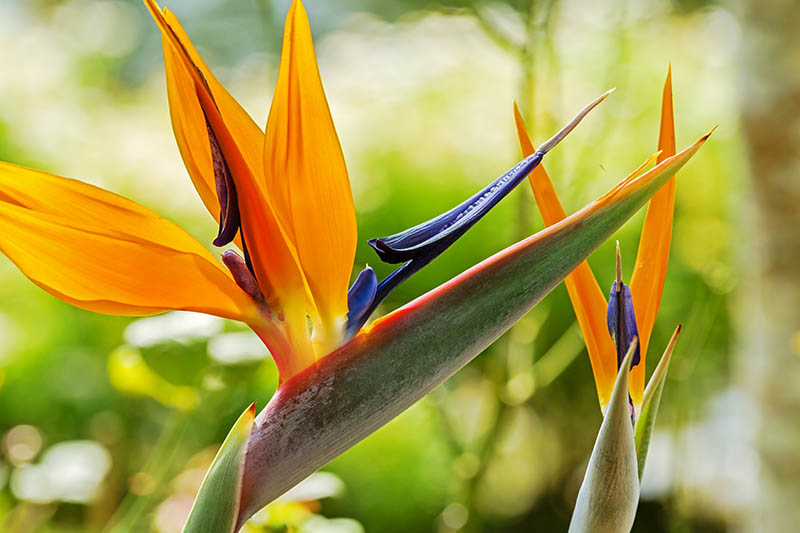
The best types of fertilizer to use include organic ones like well-rotted manure, worm castings, or blood meal, or a controlled release balanced product like Osmocote, available via Amazon, or granular landscape fertilizers.
Apply according to package instructions to a full grown clump every three months during the growing season.
If you are growing your plants in containers, you can fertilize them every two weeks with a liquid fertilizer or apply slow release pellets every two to three months.
Find more info on fertilizing here.
Growing Tips
- Plant in a full sun or part shade location.
- Provide organically-rich, well-draining soil.
- Water mature plants deeply when the soil is dry to a depth of three inches.
Pruning and Maintenance
These plants are fairly low maintenance.
The most important thing that you will need to do in terms of upkeep is to remove the dead leaves and old flower stalks, so that fungi do not build up in them.
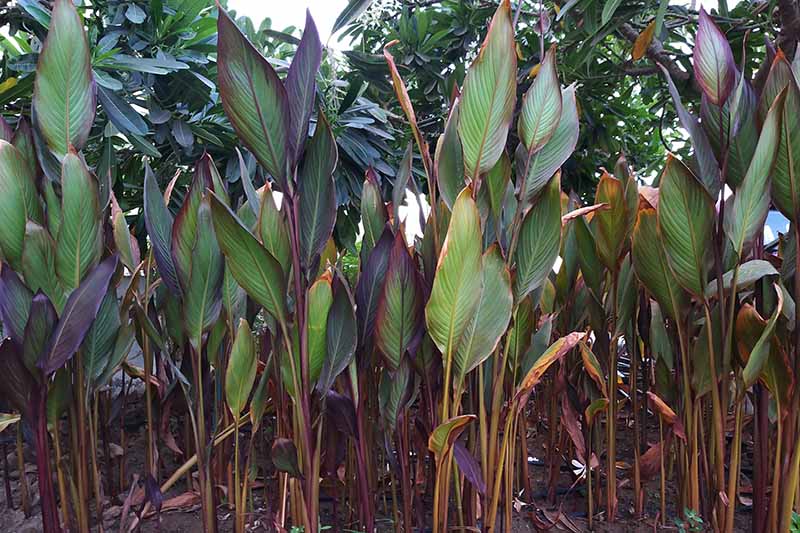
Spent flower stalks can be cut off at the base of the plant, as close to the soil line as possible. Dead or dying foliage should be cut at the point the leaf meets the stem.
If you do not prune them off, they will remain attached to the plant indefinitely.
In the case of large clumps, you can thin out the foliage from the center of the clump to allow for increased airflow.
The giant bird of paradise, S. nicolai, produces dense offshoots that you should thin occasionally.
Species and Cultivars to Select
You can usually find birds of paradise for sale at local garden centers and nurseries in areas where they thrive.
Common Bird of Paradise
Known and beloved by so many throughout the world, the orange and blue flowers of S. reginae are a dramatic addition to your landscape.
You can find plants available from Fast Growing Trees.
Giant
S. nicolai is common in south and central Florida. It is also known as giant white bird of paradise or African wild banana – thanks to its large leaves.
This species can grow up to 20 feet high and five to six feet wide, so do not mistake it for the common bird of paradise and plant it in front of a window!
Giant Bird of Paradise, S. nicolai
Plants in 9 1/4-inch pots are available from Costa Farms via Home Depot.
Mandela’s Gold
As you can probably guess from the name, ‘Mandela’s Gold’ is a South African cultivar of S. reginae. It was produced by John Winter at the Kirstenbosch National Botanic Garden in Cape Town and released in 1994.

Originally marketed as ‘Kirstenbosch Gold,’ the name was changed in 1996 to honor Nelson Mandela.
The flowers have bright yellow petals and a blue tongue. Plants grow to a mature height of four to five feet tall, with a similar spread.
You can learn more about the different types of bird of paradise plants here.
Managing Pests and Disease
Bird of paradise plants are usually free of pests and diseases, but alas, there are exceptions.
However, while pests and pathogens may attack individual flowers or leaves, they generally do not threaten the plant’s overall health.
Insects
Insects are rarely a problem, but aphids, scale, snails, grasshoppers, and caterpillars may occasionally graze on the plants. You can control them with systemic insecticides or snail bait.
Mealybugs and spider mites can infest the leaves. Just wipe them off with a soft cloth. You also have the option of using organic insecticides like neem oil to tackle an infestation.
A couple of additional species in particular may cause problems for your plants:
Opogona Crown Borers
The larvae of Opogona omoscopa moths bore into the crowns of plants, causing the foliage to turn yellow, wilt, and die. Experts believe these are secondary pests that are attracted to decaying tissue.
You can prevent this type of infestation by providing good cultural care. Remove dead or dying plant debris that attracts the moths and avoid excessive watering.
Whiteflies
While there are a number of whitefly species that attack plants, the giant whitefly (Aleurodicus dugesii) is a particular pest of bird of paradise.
Not only does this pest suck vital nutrients out of the plant, it also secretes a sugary substance called honeydew that can draw copious amounts of ants.
Early detection is important for the control of this pest. If you catch it early enough, you can spray the plants with water from the hose to remove the whiteflies.
If your plants have a severe infestation, remove any infected leaves.
Read more about controlling whiteflies here.
Find more tips on identifying and controlling bird of paradise pests here.
Disease
Several types of fungi and a common bacterial pathogen can occasionally afflict bird of paradise plants.
Armillaria Root Rot
This devastating disease can affect all members of the Strelitzia genus.
Discolored leaves are a symptom of Armillaria. Eventually, telltale clusters of what are commonly referred to as “honey mushrooms” will grow at the base of the plant.
There is no cure, and fungal colonies can live for thousands of years. You will have to remove your plant if it contracts this disease.
Prevention includes proper drainage, good irrigation, and adequate care.
Bacterial Wilt
The common bacterium Pseudomonas solanacearum can live in the soil for more than six years, and it may infect bird of paradise plants through their roots.
It can also be transmitted by infected gardening tools, plant debris, soil, insects, and water.
Initial signs of infection include wilting and yellowing of the leaves. Then, the base of the plant will begin to turn black or brown at the soil line.
If your plant is infested, you should remove and destroy it to prevent the disease from spreading.
Fungal Leaf Spot
For a nice change of pace, this type of infection – caused by a variety of fungal pathogens – is not usually a serious problem for bird of paradise plants.
Leaves that are infected develop black, tan, brown, or yellow spots or patches. They may wither and drop off the plant.
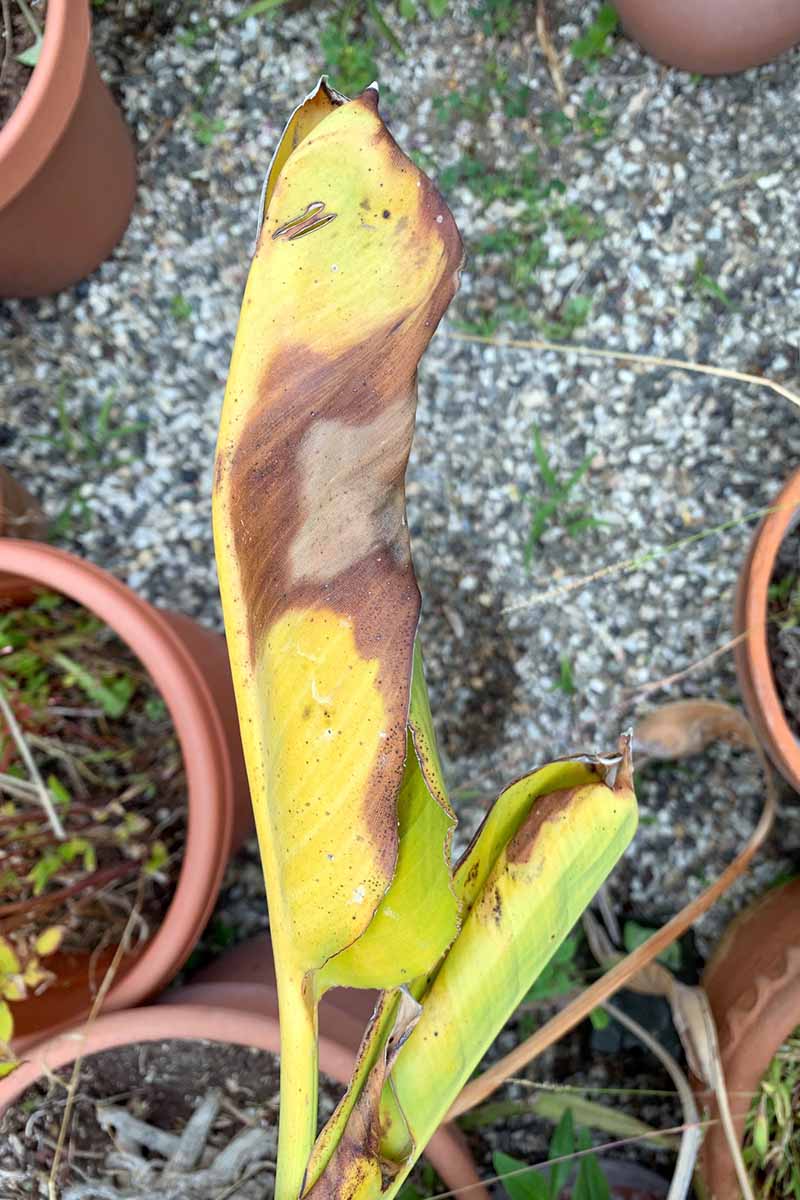
Most bird of paradise plants can handle this disease. In fact, the picture of this infection that you see above depicts an otherwise healthy plant.
Providing good cultural care and sanitation will usually help to control a fungal leaf spot infection. If necessary, you can spray plants with neem oil every 10-14 days.
Gray Mold
Also known as botrytis blight, gray mold caused by Botrytis cinerea can infect an array of plants and is well known as the cause of rot in strawberries.
Infected flowers and leaves will have a gray film over them, which gives disease its common name. Eventually, the leaves will wilt, decay, and drop from the plant.
Prevention includes removing fallen and decaying debris and dying plant tissue. Also, avoid overhead watering.
Fungicides are sometimes effective, but this fungus is notorious for developing resistance to them – sometimes during the first season of use.
In some cases, a biofungicide such as Cease can control this disease. This product contains a strain of Bacillus subtilis and is available from Arbico Organics.
Spray your plants once a week but if you have a serious infection, you can spray every three days.
Root Rot
Bird of paradise seeds can harbor a fungal pathogen that causes root rot, also known as damping off.
You can prevent this by soaking seeds at room temperature for 24 hours. Drain, then soak the seeds in 135°F water for 30 minutes.
Let them cool and dry, and then plant them in clean soil starting medium.
Find more tips on identifying and treating bird of paradise diseases here.
Best Uses for Bird of Paradise Flowers
You have probably seen these flowers in florist shops.
The plants make a beautiful focal point in a garden or a delightful houseplant in cooler regions, especially if you have a sunroom.

As if having a large perennial with stunning flowers in your yard was not enough, these types of plants have some unusual advantages.
Bird of paradise leaves are evergreen and remain on the plant. This makes them an excellent choice for adding ornamental interest near swimming pools, where shedding leaves can create a maintenance problem.

They pair well with other evergreen perennials, such as Agave vilmoriniana, Senecio mandraliscae, and Pittosporum tobira ‘Nanum’ that have similar cultural requirements.
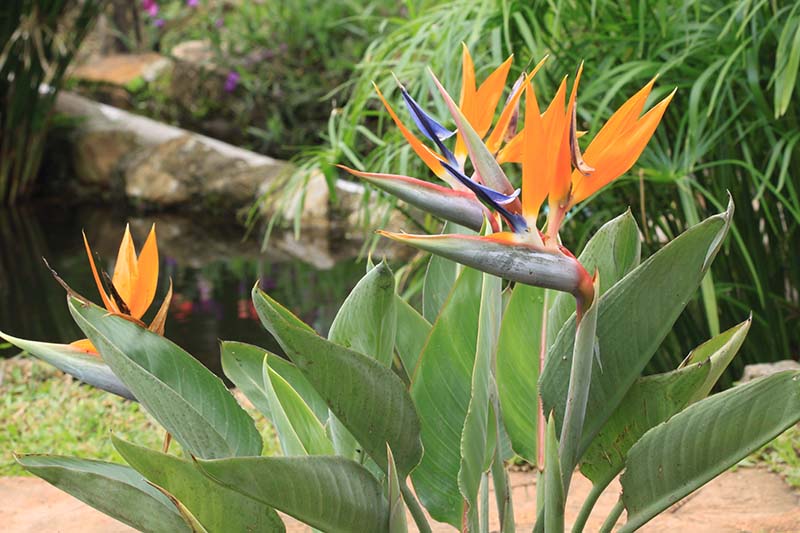
They also serve as beautiful cut flowers, and with a little care and some fresh flower food can last up to two weeks in a vase.
Learn more about how to make your fresh flowers last longer in this guide.
Quick Reference Growing Guide
| Plant Type: | Flowering herbaceous perennial | Flower / Foliage Color: | Orange, blue, and white/graysish-green, yellow/green |
| Native to: | South Africa | Maintenance: | Low |
| Hardiness (USDA Zone): | 9-12 | Soil Type: | Rich loam, chalk, sand |
| Bloom Time / Season: | Nearly year round | Soil pH: | 5.5-7.5 |
| Exposure: | Full sun, part shade | Soil Drainage: | Well-draining |
| Spacing: | 6 feet | Attracts: | Birds, hummingbirds |
| Planting Depth: | Depth of the root ball, 1/2-1 inch (seeds) | Companion Planting: | Agave vilmoriniana, Pittosporum tobira ‘Nanum’, Senecio mandraliscae |
| Height: | 3-30 feet depending on species | Uses: | Border, hedges, cut flowers, street plantings, around pools |
| Spread: | 4-6 feet | Order: | Zingiberale |
| Time to Maturity: | 1-3 years from divisions; 3-10 years from seed | Family: | Strelitziaceae |
| Water Needs: | Low to moderate | Genus: | Strelitzia |
| Tolerance: | Drought (once established) | Species: | juncea, nicolai, reginae |
| Common Pests: | Aphids, caterpillars, glassy-winged sharpshooters, grasshoppers, mealybugs, opogona crown borers, scale, spider mites, whiteflies | Common Diseases: | Armillaria, bacterial wilt, fungal leaf spot, gray mold, root rot |
A Carefree Noble Flower
Perhaps you have bought a bird of paradise flower for a loved one, or even yourself.
You may not realize that this stunning plant was once an exciting novelty from a foreign land. Now it is a low-care fixture in places with warm climates, such as southern California and Florida.

The plants are popular both for landscaping and growing as houseplants. With proper care, they will thrive and produce up to three dozen flowers a year.
Who says that you can’t have a regal garden of your very own?
Are you growing bird of paradise plants? Tell us about your experience and share your tips in the comments section below.
And for more information on how to grow other unique flowering plants, check out these guides next:
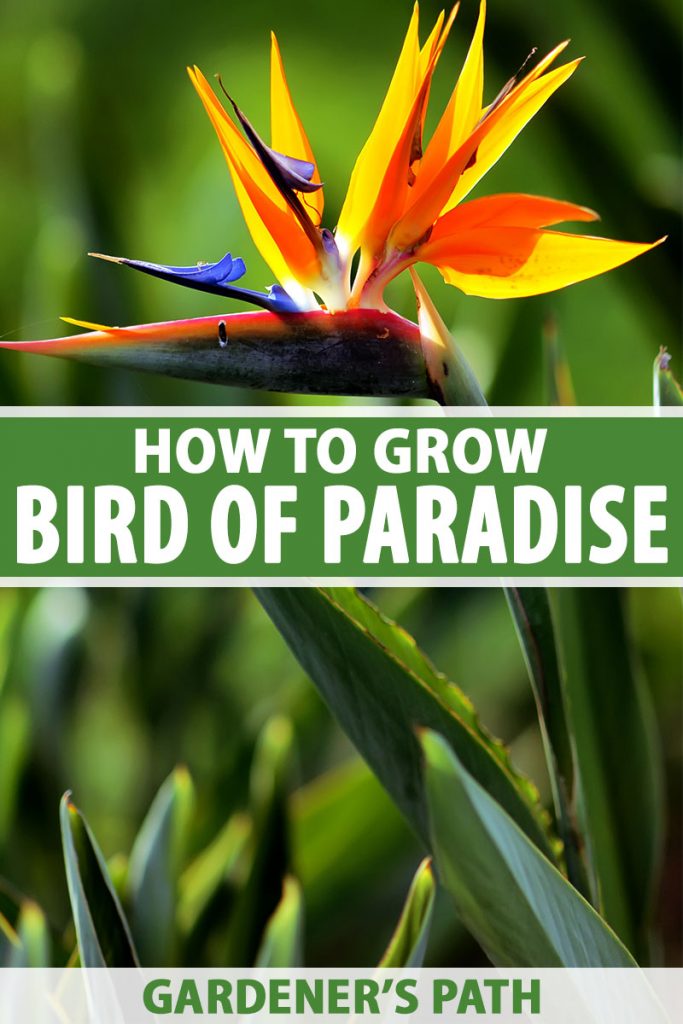
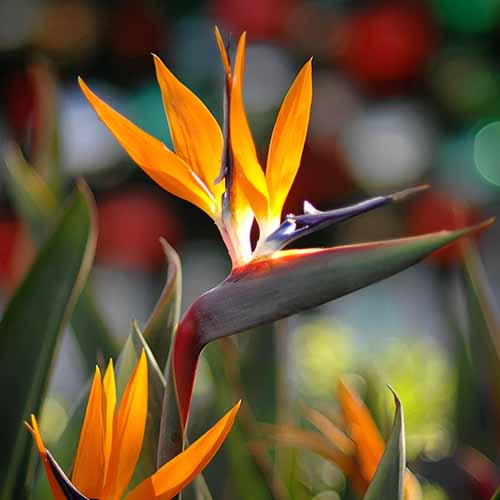

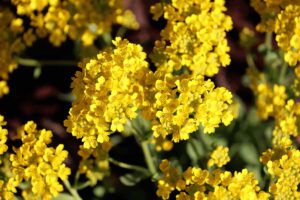

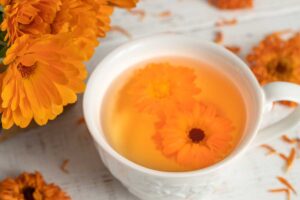
Helga — love all the information on Bird of Paradise — just inherited a plant from my mother in-law — it has one flower on it and a second one that has not blossomed yet — not sure if it will — so looking forward to propagating it in spring.
Hi Debra,
Thanks so much for your kind words!
Congratulations on the inheritance! That’s great that one of them is in bloom.
I inherited one from a rental in Santa Barbara in 1994 and hope that it will bloom this season.
I hope you can get your other one to bloom.
Quick question – my leaves are not opening on my giant South Africa bird of paradise. Any clues?
Hi Debra, I’m sorry to hear that. There could be several reasons.
1) Low light is a common reason.
2) You could have a pest infestation inside the leaves. Scale and mealybugs produce a sticky substance called honeydew that can glue the leaves together. Try misting along the leave edges with lukewarm water that contains a drop of dishwashing liquid.
3) Soil too dry
4) Low humidity
Hopefully changing your plant’s conditions will help the leaves to unfurl! If you can, keep us posted about how it is doing.
Hi Helga, I was thrilled to see your post. I have several birds of paradise that are about 18 years old and last year they developed a disease; I believe. Having a hard time identifying it online. While pruning today I took the time to look at the cut edge of the stems that are diseased looking and noticed they have brown cores in them. Like you, I too live near Santa Barbara. Maybe I can email you photos of my cut stems and plants to see if you can identify it? Thank you for being here for those I… Read more »
Hi GardenLover, I’m so glad that you found the article helpful! I’m sorry that your bird of paradise plants have a disease. Mine loses a couple leaves every years, but the rest of the plant is fine. We encourage readers to post pictures with their questions, so it would be awesome if you could upload the pictures you took. To be honest, there isn’t a lot of information on leaf diseases of bird of paradise plants, but I would still like to see the pictures in case I can help. This is such a wonderful climate! I’m in Lompoc, which… Read more »
Hi. I have a Bird of Paradise in my Lounge and it has just flowered after 5 years. I am delighted with it.
Hi Christina,
That is wonderful! I’m glad that you are able to enjoy the plant in its full glory!
Helga, I have 2 plants which I grew from seed in 1984. Both plants look very healthy. They were repotted in 2001 and again in 2010. After 14 years I had my first couple of blossoms. For about 10 years I would have 2 to 3 blossoms a year. In 2007, a banner year, I had 14 blossoms. My Mom was in a nursing home so I took some to her room and some to the nurses station. 4 days later she passed, which was a blessing. All of that time I was in Kansas City, Mo. In 2008 I… Read more »
Thanks for sharing your story, Max! I’m sorry to hear about your mother’s passing- how lovely that you were able to share your beautiful birds of paradise with her. These tend to bloom best when they are a bit rootbound, and when grown outdoors. Insufficient light is the most common issue, and they should be allowed to dry out a bit between watering. How much larger were the new pots you put them into the last time you repotted, and can you point to any other conditions that may have changed? What is different about the conditions at your new… Read more »
I have a beautiful Mandela‘s Gold – I found out to my surprise. I love it! It took about 6 months after we bought it from a specialist garden centre but we had our first flowers (x2) in Dec. (We live in London). The plant is indoor for the winter. And will go back out for the summer to our full sun roof terrace. It’s in a pot but seems happy. (I have attached a pic. Hopefully you can see it.) My question is, when we had the two flowers in bloom. There were two more flower stalks, but they… Read more »
Hi Rory, unfortunately your photo didn’t upload, can you try again?
Hi
I found these on my farm, they were farmed by the previous owners. I would like to continue taking care of them to a full hectare. I need to know how to take care of them, propagate them and multiply them. Please help achieve my goal.
Beautiful! In addition to the information provided above, you can find all of our guides to growing bird of paradise here, with tips for pruning, dividing, fertilizing, and more. Please feel free to reach out if you have any specific questions.
Thank you so much Allison
You’re welcome! Thanks for reading!
Yes I have 2 bird of paradise plants , I live in the northern part of Middle Tennessee.
I need to know how to separate for a large pot